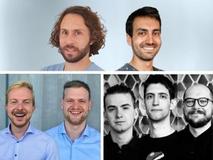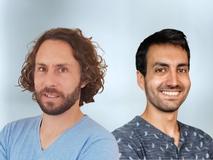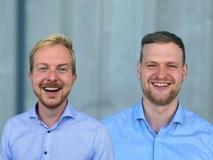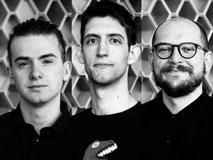CHF 40,000 for pure steam drying, to unlock semi-conductor performance, and for robotic digital manufacturing for the construction industry
24.01.2022
AquAero, Corintis, and Saeki Robotics win Venture Kick's second stage of financial and entrepreneurial support. Their projects develop a drying technology able to reduce energy consumption by up to 70% and to eliminate the CO2 emissions almost completely while maintaining high product quality and productivity; enable the future of computing in a sustainable manner to satisfy the growing demands for computational power; and allow for mass customization of large-scale components for the construction industry that greatly reduces concrete usage, waste, and emissions.
 |
 AquAero CEO Christoph Mueller and CTO Thomas Manyoky
|
 Corintis Co-Founder and CEO Remco van Erp and Sam Harrison
|
 SAEKI Robotics CEO Andrea Perissinotto, CTO Oliver Harley and COO Matthias Leschok
|
AquAero: Pure Steam Drying
AquAero has developed a new high-efficient material drying technology and is now entering the biochar market as its primary vertical. With a growth rate of roughly three times the drying market’s average, this market is in strong upwind. The next milestone in the current year is a pilot plant for IWB in Basel to dry wood for subsequent pyrolysis.
Generally, in industrialized countries, up to 25 % of the total industrial energy consumption is used for material drying, mainly driven by fossil fuels at the cost of gigantic CO2 emissions and operating expenses.
Started with the vision to provide water from the air in the middle of the desert, AquAero encountered a drying technology able to reduce energy consumption by up to 70 % and to eliminate the CO2 emissions completely while maintaining high product quality and productivity. The green technology is scalable to any size and can be adapted for all materials not sensitive to temperatures slightly above 100°C such as biomass, ceramics, food and pet food. AquAero's core team is composed of T. Manyoky, C. Müller, both mechanical engineers, and D. Meyer, electrical engineer.
The Venture Kick fund will enable AquAero to elaborate the pilot case to test Pure Steam Drying in an industrial environment. It also allows finding similar customers and investors for a seed round 2023 to corroborate the market entry. aquaero-water.com
Saeki Robotics: Robotic Digital Manufacturing for the construction industry
Concrete is the most used material on the planet - a trillion-dollar market - and is responsible for 8% of global CO2 emissions. The way in which concrete is shaped (formwork) generates large amounts of waste and is expensive for anything but simple shapes. The technologies to fabricate concrete structures are a century old and are holding back the construction of efficient elements.
The three Saeki Robotics co-founders, Andrea Perissinotto, Oliver Harley, and Matthias Leschok, are a highly interdisciplinary team; their diverse background spans across electronics/hardware design, robotics, design for manufacture, to architecture and 3D printed formwork creation. They are advised by Prof. Dr. Benjamin Dillenburger, whose research focuses on the potential of additive manufacturing for building construction. They are hosted at the ETH NCCR Dfab, one of the leading research institutions investigating the digitalization of concrete, where it has been shown that optimizing the way concrete is shaped can lead to 70% material savings (ETH Smart Slab, Dfab house). However, the techniques used are too costly for commercial use. Saeki Robotics is bridging this gap through a process they are developing called robotic digital manufacturing (RDM). By combining robotics, 3D printing, milling, post-processing, and 3D scanning in one solution they can create complex, large-scale components (like bespoke concrete. formwork) on-demand, cost-effectively, and with minimal material usage and wastage. They will provide a production service for those interested in trialing the processes and the full automation stack consisting of the hardware, software,materials, and design software to enable anyone to use their technology. Their focus is building a turnkey package that is easy to use and cuts lead times by streamlining design-to-finished-part processes.
Saeki Robotics has the potential to capture a significant share of the 65B€ European formwork market by providing their RDM platform to both construction and formwork companies .
Venture Kick funding will enable them to connect to potential customers, provide an initial production service, conduct their pilot projects and accelerate their entry into the market. saeki.ch
AquAero has developed a new high-efficient material drying technology and is now entering the biochar market as its primary vertical. With a growth rate of roughly three times the drying market’s average, this market is in strong upwind. The next milestone in the current year is a pilot plant for IWB in Basel to dry wood for subsequent pyrolysis.
Generally, in industrialized countries, up to 25 % of the total industrial energy consumption is used for material drying, mainly driven by fossil fuels at the cost of gigantic CO2 emissions and operating expenses.
Started with the vision to provide water from the air in the middle of the desert, AquAero encountered a drying technology able to reduce energy consumption by up to 70 % and to eliminate the CO2 emissions completely while maintaining high product quality and productivity. The green technology is scalable to any size and can be adapted for all materials not sensitive to temperatures slightly above 100°C such as biomass, ceramics, food and pet food. AquAero's core team is composed of T. Manyoky, C. Müller, both mechanical engineers, and D. Meyer, electrical engineer.
The Venture Kick fund will enable AquAero to elaborate the pilot case to test Pure Steam Drying in an industrial environment. It also allows finding similar customers and investors for a seed round 2023 to corroborate the market entry. aquaero-water.com
Corintis: Unlocking a new dimension in chip cooling
From cloud computing to advanced machine learning, we constantly require more powerful chips that produce ever-increasing amounts of heat. Modern GPUs now generate 35 times more concentrated heat than a barbeque, and current methods to extract the heat are holding back performance and have an enormous impact on the environment: Extracting heat represents 30% of electricity consumption in data centers, which globally accounts for more electricity consumption than all the people in New York and London combined.
Corintis breaks the limitations of conventional cooling methods by offering micro-scale liquid cooling solutions integrated into silicon, tailored to the chip layout. This results in solutions that can extract 10 times more heat compared to the current leading market alternatives with over 50 times higher energy efficiency. Corintis was co-founded by Remco van Erp, a Ph.D. student at EPFL, and Sam Harrison, and aims to make this level of performance available to the wider industry using their Glacierware platform. A full-stack thermal solution that generates custom cooling solutions based on a simple heat map. This solution addresses a market of over 10 billion USD, by charging a usage fee for cooling optimization, royalties on chip sales, and direct sales of cooling solutions.
Corintis is currently running pilot programs with interested chip manufacturers and data center operators to evaluate the impact of our cooling on their existing chips. The funds of Venture Kick will be used to accelerate these pilots, engage in commercial collaborations, and strengthen the core of Corintis’ Glacierware platform. corintis.com
Saeki Robotics: Robotic Digital Manufacturing for the construction industry
Concrete is the most used material on the planet - a trillion-dollar market - and is responsible for 8% of global CO2 emissions. The way in which concrete is shaped (formwork) generates large amounts of waste and is expensive for anything but simple shapes. The technologies to fabricate concrete structures are a century old and are holding back the construction of efficient elements.
The three Saeki Robotics co-founders, Andrea Perissinotto, Oliver Harley, and Matthias Leschok, are a highly interdisciplinary team; their diverse background spans across electronics/hardware design, robotics, design for manufacture, to architecture and 3D printed formwork creation. They are advised by Prof. Dr. Benjamin Dillenburger, whose research focuses on the potential of additive manufacturing for building construction. They are hosted at the ETH NCCR Dfab, one of the leading research institutions investigating the digitalization of concrete, where it has been shown that optimizing the way concrete is shaped can lead to 70% material savings (ETH Smart Slab, Dfab house). However, the techniques used are too costly for commercial use. Saeki Robotics is bridging this gap through a process they are developing called robotic digital manufacturing (RDM). By combining robotics, 3D printing, milling, post-processing, and 3D scanning in one solution they can create complex, large-scale components (like bespoke concrete. formwork) on-demand, cost-effectively, and with minimal material usage and wastage. They will provide a production service for those interested in trialing the processes and the full automation stack consisting of the hardware, software,materials, and design software to enable anyone to use their technology. Their focus is building a turnkey package that is easy to use and cuts lead times by streamlining design-to-finished-part processes.
Saeki Robotics has the potential to capture a significant share of the 65B€ European formwork market by providing their RDM platform to both construction and formwork companies .
Venture Kick funding will enable them to connect to potential customers, provide an initial production service, conduct their pilot projects and accelerate their entry into the market. saeki.ch


